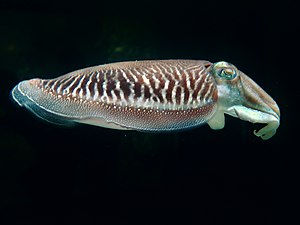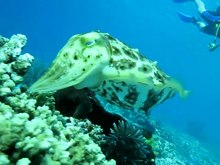Cuttlefish
| Cuttlefish | ||||||||||
|---|---|---|---|---|---|---|---|---|---|---|

Cuttlefish ( Sepiida ) |
||||||||||
| Systematics | ||||||||||
|
||||||||||
| Scientific name | ||||||||||
| Sepiida | ||||||||||
| Bather , 1888 | ||||||||||
| Familys | ||||||||||
The cuttlefish (Sepiida) or genuine squid outdated, cuttlefish (see FIG. English cuttlefish ), form an order within the Zehnarmigen squid (Decabrachia), a subset of the squid (Coleoidea). You have retained the original chalky, gas-filled casing in a heavily modified form as a sepia "shell".
features
The coat is usually more blunt and less wedge-shaped than that of the squid , but there are squid species that look very similar to the cuttlefish at first glance. The most important difference, however, is the shape of the inner skeleton, which in the cuttlefish is formed as a flat calcareous schulp . This schoolp, also known as the phragmocone , contains a multitude of gas-filled chambers that give the animal static buoyancy .
Like most other squids, the cuttlefish have a horny beak. There are ten tentacles around the mouth, most of which are relatively short. The longer tentacles (1 pair) are hidden between the rest of the arms in the resting position. The cuttlefish are stalking hunters and do not reach as high speeds as the squids. The main drive is taken over by a fin edge, which runs around the body as a band and provides propulsion with wave-like movements. The siphon is also used, but mostly only for short distances to escape.
Thousands of large Australian Sepia trees ( Sepia apama ) appear off the coast of the Australian city of Whyalla in summer . This large species of cuttlefish can reach a length of 60 centimeters and a weight of over five kilograms.
Way of life
Habitat and nutrition
Unlike the squid , the cuttlefish are not adapted to life in the open water ( pelagic ) of the oceans , they mainly live near the bottom. They feed on fish and crabs.
camouflage
Most cuttlefish are able to change color and can burrow in a flash. Because of this, they can camouflage themselves very well and do not need to flee far from enemies. However, the animals also signal their mood by changing color, such as willingness to mate or stress.
The ink bag, which contains a dark ink made from concentrated melanin, also serves as camouflage . This was previously used as sepia for coloring clothes or photo paper , today it is used almost exclusively as a dye for black pasta ( seppia ).
pairing
Cuttlefish meet in large flocks to mate. The males fight rivalries for the females. If a male meets a conspecific directly, its surface takes on the striped pattern of the courtship color and the arms are stretched out to the side. If the appearance of the conspecific changes in the same way as a reaction to this, he will be recognized as a male competitor and attacked. If there is no change in the other person, it is a female.
Once a pair has been found, the male uses his mating arm, the hectocotylus , to transfer a spermatophore into a storage pocket under the female's oral cavity, where it is kept until fertilization. The eggs are born one by one. To do this, the female puts her arms together to form a tube in which the eggs are transported past the sperm store and thus fertilized. At the end of the tube, the tips of the arms form two tips from the secretion shell of the egg, with which the eggs are attached to aquatic plants or other structures. Shortly after mating and laying eggs, the animals die.
Economical meaning
Squids are nutritious and tasty and are therefore prepared as a food, especially in Mediterranean and Asian cuisine .
Because of the particular thickness of the axons of their neurons , they were preferred objects of neuroscientific research. In the 1940s, an action potential was measured for the first time on what is known as the giant octopus axon, and the mechanism by which nerve excitation occurs was also explained.
The back shoulder (float) of the squid is used both as a mold for goldsmithing and as a food supplement, e.g. for canaries , but also in terraristics (important minerals and lime). It can also be used as a very fine abrasive. It is whitish, porous and made of calcareous material. It is not only captured when fishing for squid, it can also be found as flotsam on beaches.
Systematics
The following list contains the families and genera currently assigned to the order Sepiida (and individual species for which articles are available).
-
Sepiidae Leach, 1817
-
Sepia Linnaeus, 1758
- Giant sepia ( Sepia apama )
- Broad-arm sepia ( Sepia latimanus )
- Common squid ( Sepia officinalis )
-
Metasepia Hoyle, 1885
- Splendid Sepia ( Metasepia pfefferi )
- Sepiella Gray, 1849
-
Sepia Linnaeus, 1758
-
Sepiadariidae fishermen, 1882
- Sepiadarium Steenstrup, 1881
- Sepioloidea d'Orbigny, 1845
-
Idiosepiidae Appelöf, 1898 (some authors also accept this family as an order).
- Idiosepia Steenstrup, 1881
- † Belosaepiidae Nyst, 1843
- † Belosepiellidae Naef, 1921
The family Sepiolidae Leach, 1817 is now mostly placed as a separate order Sepiolida ( dwarf squid ) on an equal footing with the order of the Sepia.
The following cladogram illustrates the parentage relationships:
| Cuttlefish |
|
||||||||||||||||||||||||||||||||||||
|
|
literature
- Patrizia Jereb and Clyde FE Roper: Cephalopods of the World - An Annotated and Illustrated Catalog of Cephalopod Species Known to Date. Volume 1 Chambered Nautiluses and Sepioids (Nautilidae, Sepiidae, Sepiolidae, Sepiadariidae, Idiosepiidae and Spirulidae). FAO Species Catalog for Fishery Purposes, No. 4, 1: 1-262, Rome 2005 ISBN 92-5-105383-9
- Mark Norman: Cephalopods A World Guide. 319 pp., ConchBooks, Hackenheim 2000 ISBN 3-925919-32-5
- Kir Nazimovich Nesis: Cephalopods of the World - squids, cuttlefishes, octopuses, and allies. 351 pp., Neptune City, NJ: TFH Publ. ISBN 0-86622-051-8
Web links
- Cephalopods: Sepia from weichtiere.at.
- Escape in slow motion




